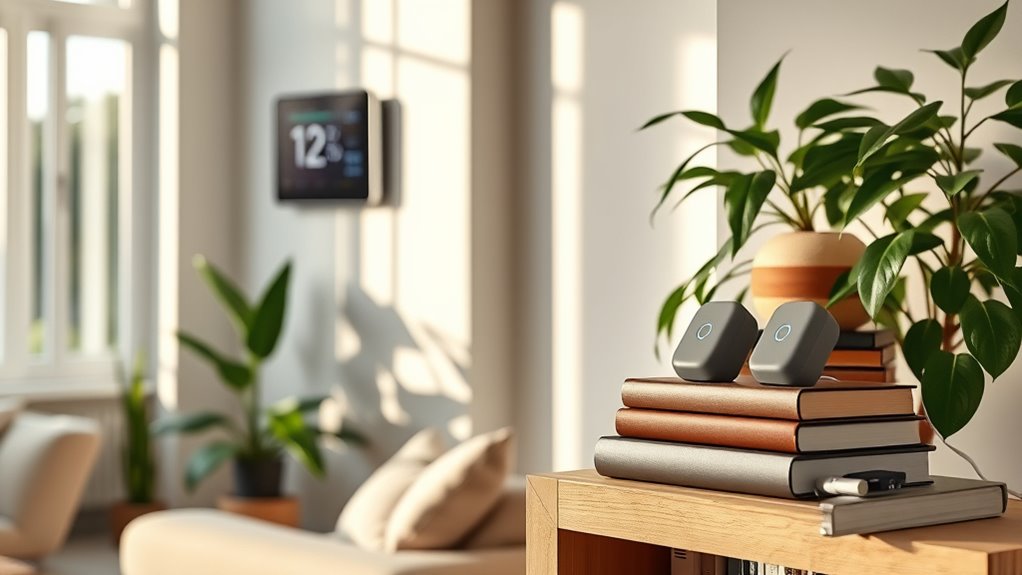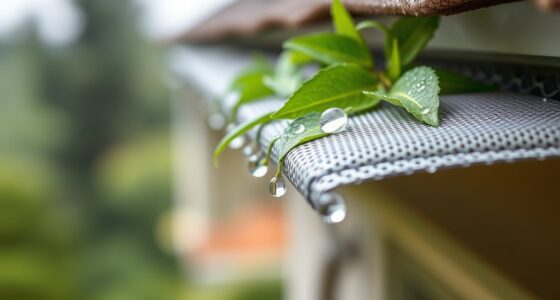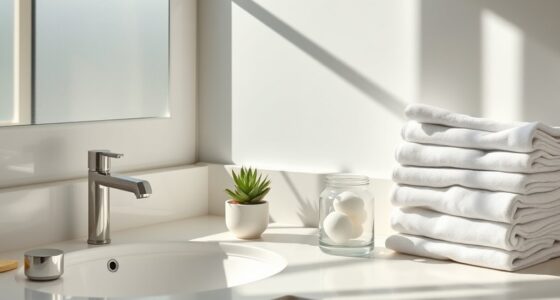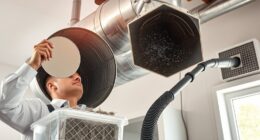Using sensors to monitor indoor air quality helps you maintain a healthy and comfortable home. These devices detect pollutants like VOCs, particulate matter, and CO₂ in real time, allowing you to take immediate action. They can automatically activate air purifiers and adjust ventilation systems to improve air quality. By continuously tracking data, you’ll better understand your environment and create a smarter, safer living space. Keep exploring to discover how these innovations can transform your home safety.
Key Takeaways
- Sensors provide real-time data on pollutants, allergens, and toxins to maintain healthy indoor air quality.
- Automated systems use sensor readings to activate air purifiers and adjust ventilation for optimal air conditions.
- Monitoring humidity and particulate levels helps prevent mold and airborne contaminants, promoting a healthier environment.
- Data-driven insights enable targeted interventions, reducing health risks and improving overall indoor air quality.
- Regular sensor use supports proactive maintenance and ensures continuous indoor air safety and comfort.
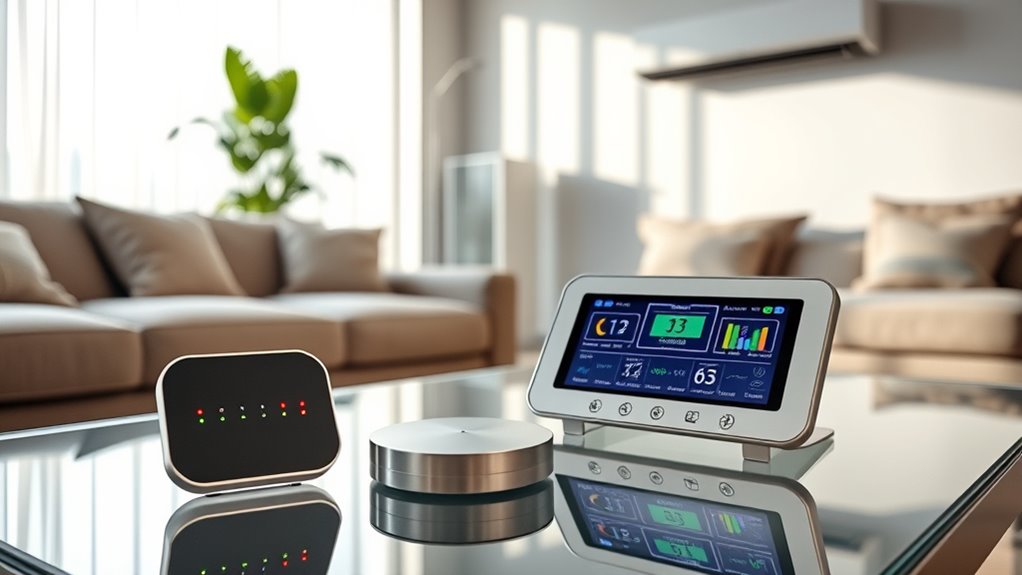
Indoor air quality monitoring is essential for ensuring a healthy and comfortable living or working environment. When you actively monitor your indoor air, you gain valuable insights into what’s circulating in your space—be it pollutants, allergens, or toxins—and how to improve it. Sensors play a pivotal role in this process, providing real-time data that helps you make informed decisions. By keeping an eye on air quality levels, you can take immediate action to reduce risks and promote well-being.
Monitoring indoor air quality helps you understand pollutants and take timely actions to ensure a healthier environment.
One of the most effective ways to enhance indoor air quality is through proper air purification. When sensors detect elevated levels of pollutants like VOCs, particulate matter, or carbon dioxide, you can activate air purifiers to remove these contaminants. Modern air purifiers with integrated sensors automatically adjust their operation based on air quality readings, ensuring you don’t waste energy while maintaining a clean environment. This seamless integration helps you sustain fresh, breathable air without constant manual intervention.
Ventilation systems also become more efficient when paired with air quality sensors. Traditional ventilation relies on fixed schedules or manual adjustments, which can be ineffective if pollutant levels fluctuate unexpectedly. With sensors in place, you can optimize ventilation by increasing airflow when needed—such as during cooking, cleaning, or when there’s outdoor pollution—and reducing it when air quality improves. This not only improves air freshness but also conserves energy, making your home or office more sustainable.
Monitoring tools give you a clear picture of how well your ventilation systems are performing. If sensors indicate poor air quality despite active ventilation, you might need to inspect or upgrade your systems. Conversely, if air quality remains high, you can relax, knowing your current setup is sufficient. This continuous feedback loop lets you fine-tune your environment, ensuring it remains healthy and comfortable over time.
Furthermore, understanding your indoor air quality through sensor data empowers you to implement targeted solutions. For example, if high humidity is detected, mold growth becomes a concern, and you can address it by improving ventilation or using dehumidifiers. If particulate levels spike during cleaning, you can choose better filtration options or schedule cleaning activities at different times. This proactive approach helps you create a safer space tailored to your specific needs.
In essence, utilizing sensors for indoor air quality monitoring transforms your environment into a smart, responsive space. By integrating air purification and ventilation systems guided by precise data, you enhance both health and comfort. Staying vigilant with real-time updates allows you to maintain ideal indoor air quality, reducing health risks and boosting overall well-being. With these tools, creating a healthier home or workspace isn’t just possible—it’s straightforward and effective. Additionally, the importance of lifestyle choices can significantly influence indoor air quality, emphasizing the need for comprehensive environmental awareness.
Frequently Asked Questions
How Often Should Indoor Air Quality Sensors Be Calibrated?
You should calibrate your indoor air quality sensors at least once every 6 to 12 months, depending on the sensor type and manufacturer’s recommendations. Regular sensor maintenance and calibration intervals guarantee accurate readings, helping you maintain a healthy home environment. Keep an eye on any calibration alerts or performance issues, and follow the manufacturer’s instructions for calibration procedures to ensure your sensors remain reliable over time.
Can Sensors Detect All Indoor Air Pollutants Accurately?
Sensors can’t detect all indoor air pollutants accurately because of their limitations and pollutant specificity. You should know that some sensors excel at measuring certain gases like CO2 or VOCs but may miss others such as particulate matter or radon. Relying solely on sensors might lead to gaps in air quality data. To guarantee a thorough view, combine sensor readings with periodic professional testing for pollutants that are harder to detect.
What Is the Typical Lifespan of Indoor Air Quality Sensors?
Indoor air quality sensors typically last between 2 to 5 years, depending on their sensor durability and usage conditions. You should follow recommended replacement schedules to guarantee accurate readings. Factors like environmental exposure and device quality can affect lifespan, so regularly check your sensors and replace them as advised by the manufacturer to maintain ideal indoor air monitoring and assure your home’s air stays healthy.
Are There Any Privacy Concerns With Indoor Air Quality Monitoring?
Are you worried about privacy when using indoor air quality sensors? You probably should be, as data privacy and user consent are vital concerns. These sensors collect sensitive information about your home’s environment, which could be misused if not properly protected. Always check if the device manufacturer prioritizes data privacy and guarantees transparent user consent processes. Staying informed helps you enjoy healthier indoor air without compromising your privacy.
How Do Sensor Readings Translate Into Actionable Health Advice?
Sensor data interpretation helps you identify when air quality drops below healthy levels. Based on these readings, health recommendation strategies suggest actions like increasing ventilation, using air purifiers, or reducing pollutant sources. By regularly reviewing your sensor data, you can make informed decisions to improve indoor air quality, reducing health risks and creating a safer, healthier home environment. This proactive approach guarantees you stay ahead of potential indoor air issues.
Conclusion
By monitoring indoor air quality with sensors, you can create a healthier home environment. Did you know that poor indoor air quality is linked to respiratory issues in up to 30% of asthma cases? Staying aware of pollutants and VOC levels helps you take quick action to improve air circulation and ventilation. With these tools, you can breathe easier and reduce health risks, making your home a safer, more comfortable space for everyone.
